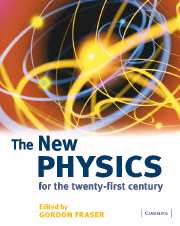Book contents
- Frontmatter
- Contents
- Contributors
- Editor’s acknowledgements
- Introduction: The new physics for the Twenty-First Century
- I Matter and the Universe
- II Quantum matter
- 6 Manipulating atoms with photons
- 7 The quantum world of ultra-cold atoms
- 8 Superfluids
- 9 Quantum phase transitions
- III Quanta in action
- IV Calculation and computation
- V Science in action
- Index
9 - Quantum phase transitions
Published online by Cambridge University Press: 05 June 2014
- Frontmatter
- Contents
- Contributors
- Editor’s acknowledgements
- Introduction: The new physics for the Twenty-First Century
- I Matter and the Universe
- II Quantum matter
- 6 Manipulating atoms with photons
- 7 The quantum world of ultra-cold atoms
- 8 Superfluids
- 9 Quantum phase transitions
- III Quanta in action
- IV Calculation and computation
- V Science in action
- Index
Summary
Introduction
We all observe phase transitions in our daily lives, with hardly a second thought. When we boil water for a cup of tea, we observe that the water is quiescent until it reaches a certain temperature (100 ℃), and then bubbles appear vigorously until all the water has turned to steam. Or after an overnight snowfall, we have watched the snow melt away when temperatures rise during the day. The more adventurous among us may have heated an iron magnet above about 760 ℃ and noted the disappearance of its magnetism.
Familiar and ubiquitous as these and many related phenomena are, a little reflection shows that they are quite mysterious and not easy to understand: indeed, the outlines of a theory did not emerge until the middle of the twentieth century, and, although much has been understood since then, active research continues. Ice and water both consist of molecules of H2O, and we can look up all the physical parameters of a single molecule, and of the interaction between a pair of molecules, in standard reference texts. However, no detailed study of this information prepares us for the dramatic change that occurs at 0 ℃. Below 0 ℃, the H2O molecules of ice are arranged in a regular crystalline lattice, and each H2O molecule hardly strays from its own lattice site. Above 0 ℃, we obtain liquid water, in which all the molecules are moving freely throughout the liquid container at high speeds. Why do 1023 H2O molecules cooperatively “decide” to become mobile at a certain temperature, leading to the phase transition from ice to water?
- Type
- Chapter
- Information
- The New PhysicsFor the Twenty-First Century, pp. 229 - 254Publisher: Cambridge University PressPrint publication year: 2006
- 7
- Cited by

